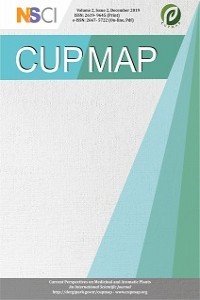BIOAPYGIN HERBAL OINTMENT AND PESSARIES COMPARED TO ACIDOSALUS PESSARIES AND VAGINAL PROBIOTIC IN THE TREATMENT OF VULVO-VAGINAL DISORDERS
BIOAPYGIN HERBAL OINTMENT AND PESSARIES COMPARED TO ACIDOSALUS PESSARIES AND VAGINAL PROBIOTIC IN THE TREATMENT OF VULVO-VAGINAL DISORDERS
Bioapygin, Acidosalus, vulvo-vaginal disorders vaginal pH, herbal macerates,
___
- 1. Abdelmonem, A.M., Rasheed, S.M., Mohamed, A., 2012. Bee-honey and yogurt: a novel mixture for treating patients with vulvovaginal candidiasis during pregnancy. Archives of Gynecology and Obstetrics, 286(1), 109-114.
- 2. Banaeian, S., Sereshti, M., Rafieian, M., Farahbod, F., Kheiri, S., 2017. Comparison of vaginal ointment of honey and clotrimazole for treatment of vulvovaginal candidiasis: A random clinical trial. Journal of Medical Mycology, 27(4), 494-500.
- 3. Boskey, E.R., Telsch, K.M., Whaley, K.J., Moench, T.R., Cone, R.A., 1999. Acid production by vaginal flora in vitro is consistent with the rate and extent of vaginal acidification. Infection and Immunity, 67, 5170–5175.
- 4. Caillouette, J.C., Sharp, C.F. Jr, Zimmerman, G.J., Roy, S., 1997. Vaginal pH as a marker for bacterial pathogens and menopausal status. American Journal of Obstetrics and Gynecology, 176, 1270–1275.
- 5. Calleja-Agius, J., Brincat, M.P., 2015. The urogenital system and the menopause. Climacteric, 18 Suppl 1,18-22.
- 6. Darvishi, M., Jahdi, F., Hamzegardeshi, Z., Goodarzi, S., Vahedi, M., 2015. The Comparison of Vaginal Cream of Mixing Yogurt, Honey and Clotrimazole on Symptoms of Vaginal Candidiasis. Global Journal of Health Science, 7(6): 108–116.
- 7. Klebanoff, S.J., Hillier, S.L., Eschenbach, D.A., Waltersdorph, A.M., 1991. Control of the microbial flora of the vagina by H2O2-generating lactobacilli. Journal of Infectious Diseases, 164, 94–100.
- 8. Larsen B., 1993. Vaginal flora in health and disease. Clinical Obstetrics and Gynecology, 36(1), 107-121.
- 9. Milsom, I., Arvidsson, L., Ekelund, P., Molander, U., Eriksson, O., 1993. Factors influencing vaginal cytology, pH and bacterial flora in elderly women. Acta Obstetricia et Gynecologica Scandinavica, 72, 286–291.
- 10. Oreščanin, V., Findri Guštek, Š., 2017. Application of Bioapigyn Herbal Ointment for the Treatment of Lower Genital Tract Infections. Indian Journal of Pharmaceutical Education and Research, 51(3s), 176-179.
- 11. Panda, S., Das, A., Santa Singh, A., Pala, S., 2014. Vaginal pH: A marker for menopause. Journal of Midlife Health, 5(1), 34–37.
- 12. Pandit, L., Ouslander, J.G., 1997. Postmenopausal vaginal atrophy and atrophic vaginitis. American Journal of Medical Science, 314, 228–231.
- 13. Redondo-Lopez, V., Cook, R.L., Sobel, J.D., 1990. Emerging role of lactobacilli in the control and maintenance of the vaginal bacterial microflora. Reviews of infectious diseases, 12, 856–872.
- 14. Roy, S., Caillouette, J.C., Roy, T., Faden, J.S., 2004. Vaginal pH is similar to follicle-stimulating hormone for menopause diagnosis. American Journal of Obstetrics and Gynecology, 190, 1272–1277.
- 15. Tuntiviriyapun, P., Panyakhamlerd, K., Triratanachat, S., Chatsuwan, T., Chaikittisilpa, S., Jaisamrarn, U., Taechakraichana, N., 2015. Newly developed vaginal atrophy symptoms II and vaginal pH: a better correlation in vaginal atrophy? Climacteric, 18(2), 246-251.
- 16. Vahidroodsari, F., Ayati, S., Yousefi, Z., Saeed, S., 2010. Comparing Serum Follicle-Stimulating Hormone (FSH) Level with Vaginal pH in Women with Menopausal Symptoms. Oman Medical Journal, 25(1), 13-26.
- ISSN: 2619-9645
- Yayın Aralığı: Yılda 2 Sayı
- Başlangıç: 2018
- Yayıncı: Nazım ŞEKEROĞLU
Višnja OREŠČANİN, štefica FİNDRİ GUŠTEK
Jaya ARORA, Bhanupriya KANTHALIYA, Abhishek JOSHI
Violeta DİMİTROVA, Alexander TASHEV
Rüveyde TUNÇTÜRK, Murat TUNÇTÜRK, Lütfi NOHUTCU
Ethnopharmacological Survey on Phlomis grandiflora: in vivo Antihemorrhoidal Model
Ceylan DÖNMEZ, Ufuk KOCA ÇALIŞKAN
Antimicrobial Activity of Different Flower Extracts
Kenan TUNÇ, Alican Bahadır SEMERCİ, Dilek İNCEÇAYIR, Mehmet Sağıroğlu SAĞIROĞLU
